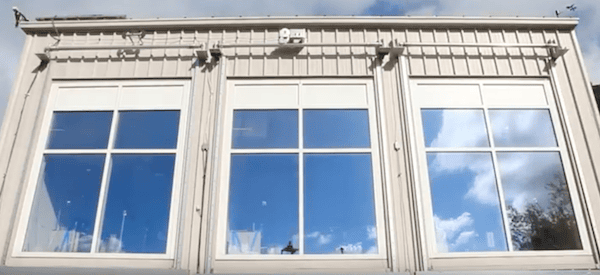
[Image above] Credit: Berkeley Lab, YouTube
This year, the summer’s heat has been testing everyone’s air conditioners as well as their patience.
According to the U.S. Department of Energy, heat gain and heat loss through windows represent 25-30% of residential heating and cooling energy use. Commercially, energy use associated with window performance costs U.S. building owners nearly $50 billion per year—which represents 5% of all energy used in the U.S.
Researchers have been exploring ways of making windows more energy efficient since the early 20th century.
And they’re not finished yet.
Researchers at Lawrence Berkeley National Laboratory (Berkeley Lab) have studied ways to improve windows for close to 50 years. So it’s not surprising that they have developed a window that is more than “twice as insulating as 99 percent of the windows for sale today,” according to a Berkeley Lab news release.
Dubbed the “super window,” Berkeley Lab’s triple pane window’s thermal performance is twice as powerful than current Energy Star-rated double-glazed windows. It’s seven times more insulating than a single-glazed window. And it represents a “giant leap” of technology devoted to reducing energy consumption.
Conventional double-pane windows are made of two coated Low-E glass panes with argon gas in between the layers to increase insulating abilities by reducing heat transfer.
The super window is made of two layers of Low-E glass enclosing a very thin third layer of Low-E glass in the middle. And researchers replaced the argon gas between the panes with—you guessed it—krypton! Instead of destroying the window’s superpowers like kryptonite did with Superman, krypton actually improves its insulating powers.
According to the release, Berkeley Lab’s super windows are superior to other triple-pane windows on the market because they’re designed to be the standard width and weight of existing double-pane windows. The standard design enables consumers to easily replace their existing windows.
Berkeley Lab’s researchers are currently working with major window manufacturers such as Andersen and Alpen to test prototypes of the super window.
“Our approach is to attack the problem from two sides: to develop both ‘market pull’ and ‘technology push’ forces,” Berkeley Lab researcher Steve Selkowitz, one of the inventors of the super window, says in the release. “Our role is to be a catalyst in facilitating technological innovation and an evangelist in promoting DOE’s energy-efficiency mission.
“We helped create a multibillion-dollar per year market in high-performance windows with huge energy savings,” Selkowitz adds. “Now we hope to make another leap in window efficiency and extend our past success.”
Based on Berkeley Lab’s history of window research, the super window might just be the giant leap of innovation that could save the planet.
Just like Superman.
Watch the video below to learn more about the super window.

Credit: Berkeley Lab, YouTube
Did you find this article interesting? Subscribe to the Ceramic Tech Today newsletter to continue to read more articles about the latest news in the ceramic and glass industry! Visit this link to get started.
Author
Faye Oney
CTT Categories
- Energy
- Environment
- Glass
- Manufacturing
- Market Insights
- Material Innovations


